Piaggio Museum almost doubles floor space
After 18 years of activity and a level of success confirmed by its 600,000 visitors, the Piaggio Museum has been extended from 3000 to 5000 square metres, with more than 250 important pieces exhibited.
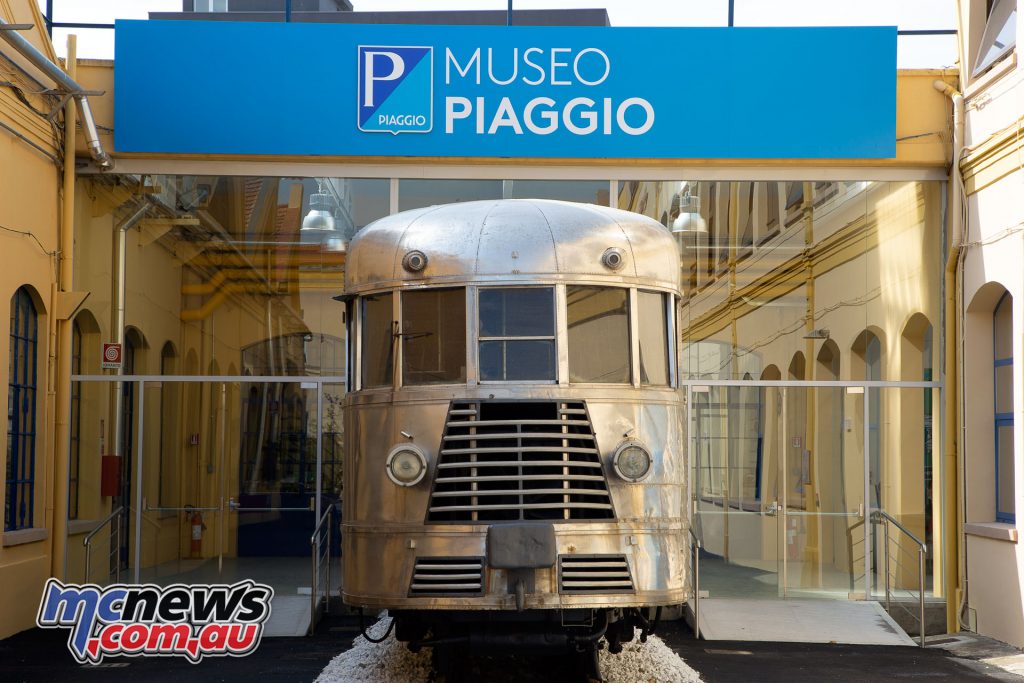
The largest and most comprehensive Italian museum dedicated to two wheels includes many unique examples that do not just tell of the history of the Piaggio Group and its brands, but also trace the history of a country’s mobility and industrial and social development. The Piaggio story spans the entire history of transport: ships, trains, aeroplanes, cars, scooters and motorcycles have been born out of the parent company and its brands.
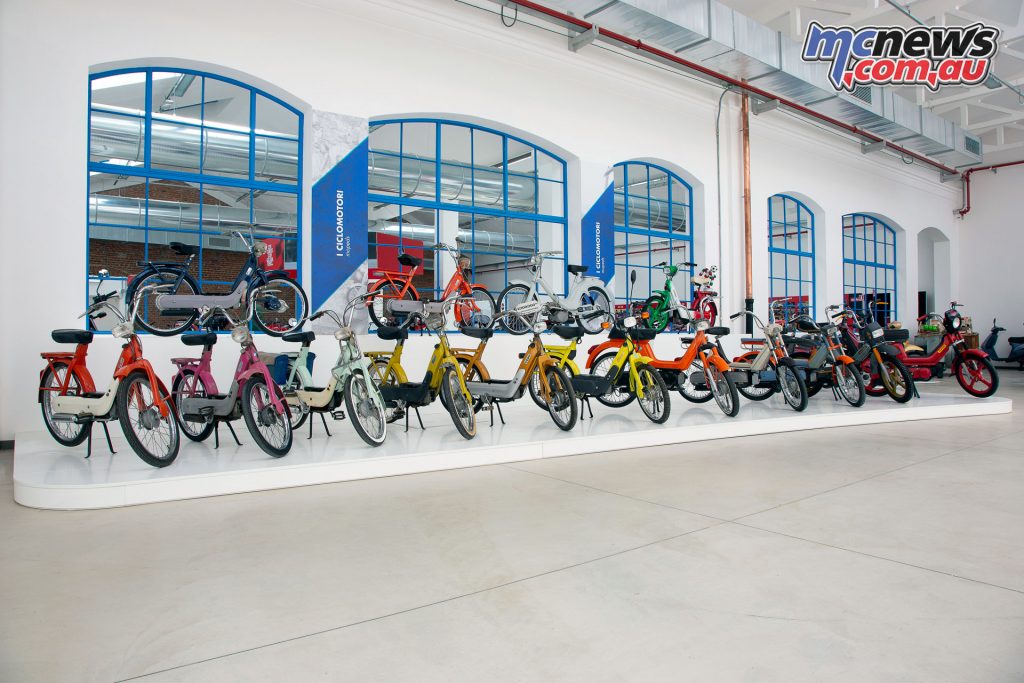
Roberto Colaninno, CEO and MD of the Piaggio Group
“Piaggio has based its history and its success on innovation, on the ability to imagine a future invisible to others, to interpret the needs of the people all over the world, both in western markets and in emerging countries. The Piaggio Group is present with its brands (Piaggio, Vespa, Moto Guzzi, Aprilia, Gilera, Derbi and Ape) in India, in Vietnam, in China and in Indonesia, accompanying the economic and social development of those populations, creating new mobility solutions to make life more and more simple and sustainable, just as it has done in Europe and the United States since the post-war era through to the present. This museum does not simply put splendid vehicles and impressive engineering on display, but it tells many stories make up of extraordinary ingenuity and great courage, emotions, competitions and victories, technological, economic and social transformations. Here we conserve the teachings that have been handed down by our heritage and, at the same time, we continue to write it, pursuing the path of constant innovation, consistently and creatively following the same values that have guided us for more than 130 years”.
The Museum is the only one in Italy able to trace the history of a such a highly technological and innovative industry, the evolution of which has marked the history of Italy and Europe.
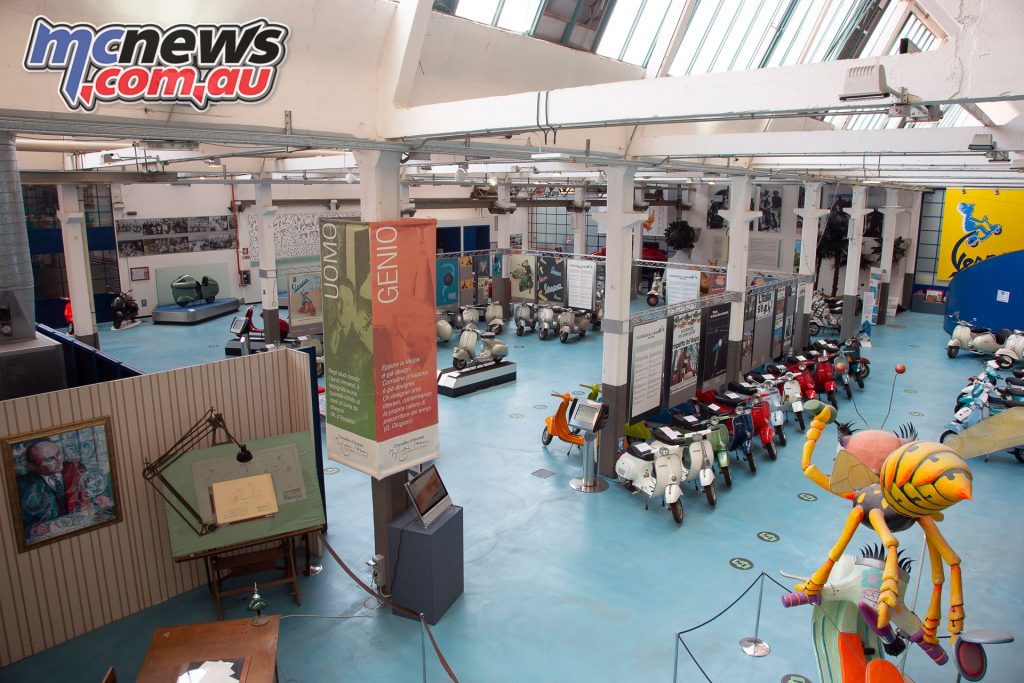
The increase in exhibition areas is the result of adding two brand new spaces, as per the original concept of the Museum, created by recovering and restoring old industrial sites. Spaces where Vespas and Piaggio vehicles were manufactured until the late ’70s, later transformed into warehouses and then abandoned with the modernisation and moving of the production lines, are now recovered for museum use.
The new collections are housed here, one dedicated to the Piaggio and Ape brands and the other to the motorcycling and racing history of the Aprilia, Gilera and Moto Guzzi brands that, together, have accumulated a total of 104 world titles across the various motorcycle specialisms, from Supermoto to MotoGP, from Trials to SBK.
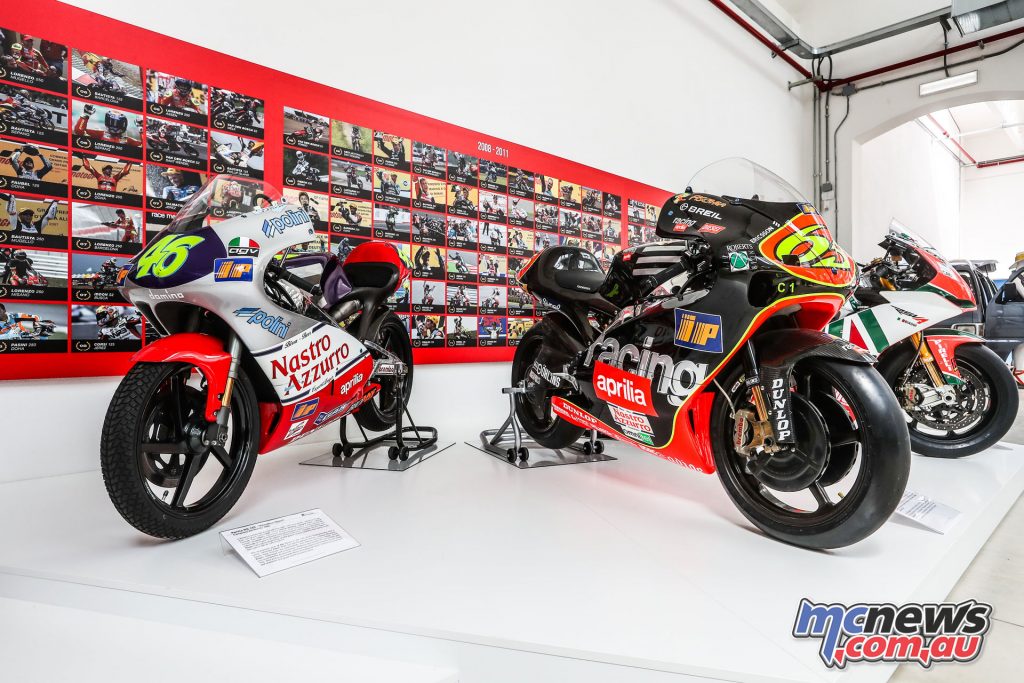
Alongside the exhibition space dedicated to permanent collections, the Piaggio Museum also dedicates 340m² to temporary exhibitions, allowing the museum to continuously vary its cultural offer, spanning fields from art to technology, and from scientific disclosure to fashion.
Inaugurated in March 2000, the Piaggio Museum occupies one of the oldest and most evocative units of the Pontedera factory complex and also houses the Piaggio Historic Archive, one of the richest and most comprehensive testaments to European industrial history.
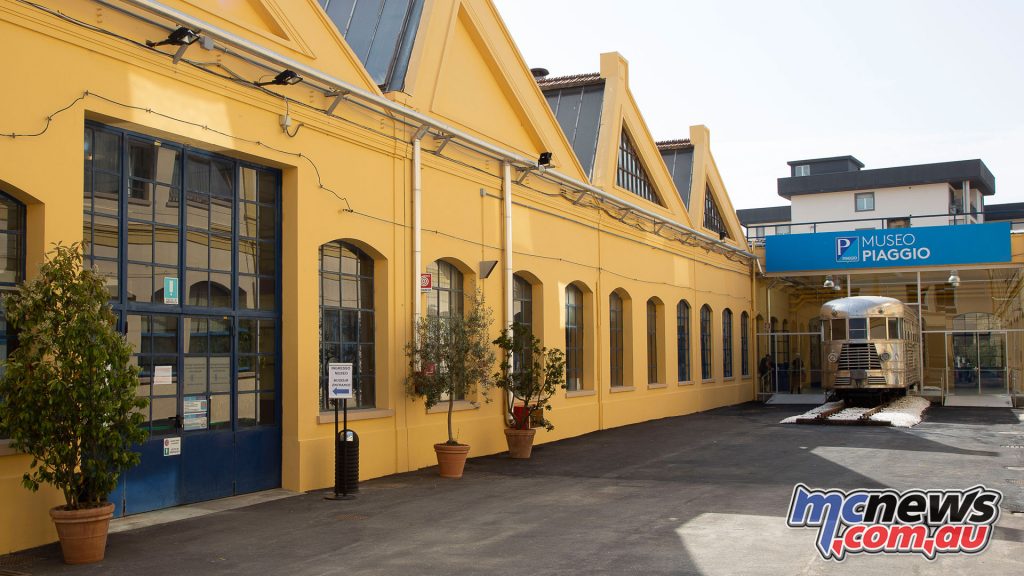
The Piaggio Historic Archive conserves documentation from the company’s origins right up to the present day, in the form of thousands of original documents. In 2003, the Piaggio Museum and the Historic Archive were awarded Best Museum and Best Business Archive in Italy, during the 2003 Business and Culture Prize-giving.
Rail and aeronautical production
Two fundamental testaments to Piaggio aeronautical and rail production welcome the visitor at the Museum’s entrance: an example of the M2 DE 54 train engine (1936), used on the Calabro-Lucane railway, literally “breaks through” the Museum entrance’s glass window and is testament to the advanced Piaggio technology that led to the construction of railcars, electric trains and ordinary vehicles using only stainless steel, the firm being the first in Italy to do so.
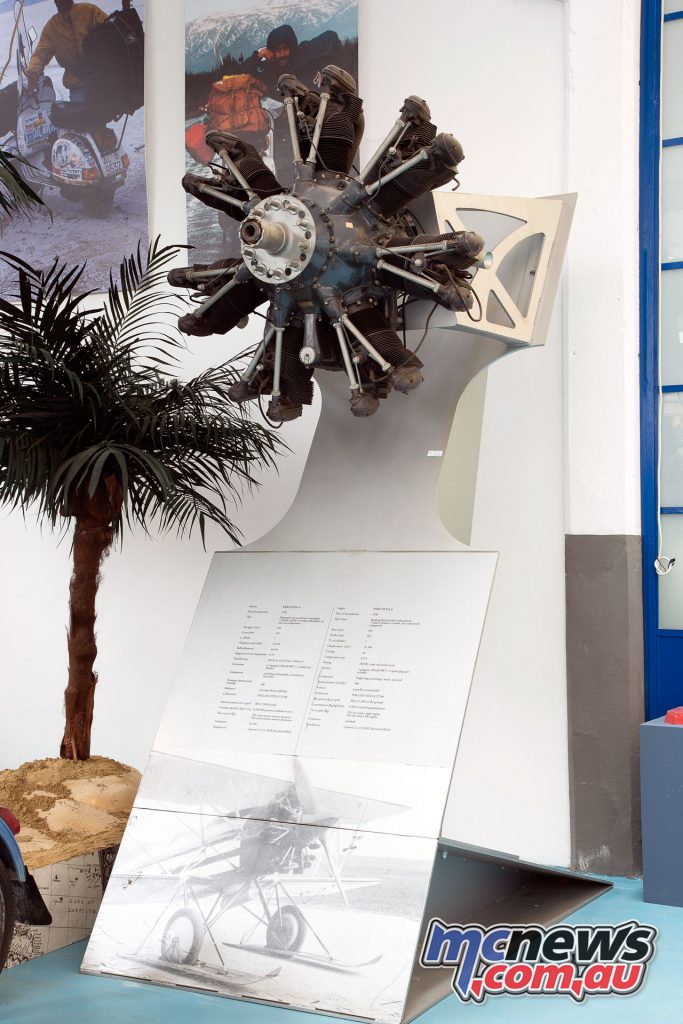
In the square, positioned as if on a landing strip, is the P148 plane, a 1951 two-seater used for aerobatic training. Inside the museum are two large “stellar” aeronautical engines, the P VII (1934) and the P XI (1938), built in the Pontedera and Pisa factories, which dominate the central space from on high.
The Vespa Collection
At the Piaggio Museum guests admire rare and precious prototypes from the 1940s, exhibited together. Examples that represent the earliest chapters in Vespa history, such as the MP5, known as “Paperino”, which marked Piaggio’s first venture into the scooter world, with only a few examples produced between 1944 and 1946, and the MP6, the true Vespa prototype designed at the hands of Corradino d’Ascanio in the autumn of 1945.
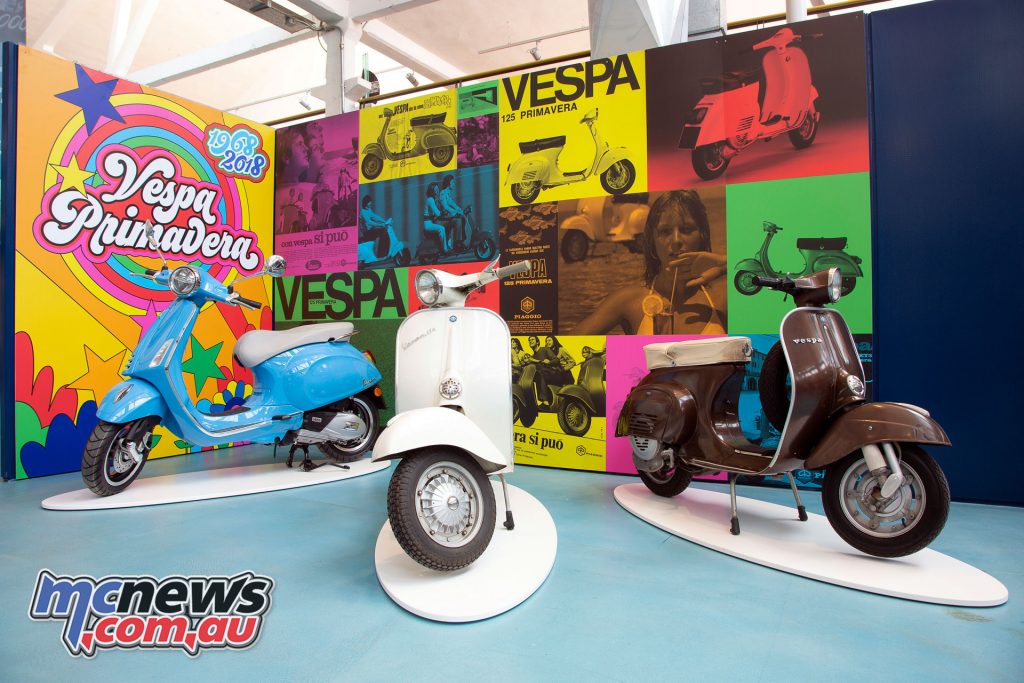
Production bikes include all the “classics” that have contributed to what is now a legendary story, starting with the first series of the April 1946 Vespa 98 cc before continuing with milestones such as the 1951 Vespa 125 (made famous by Roman Holiday), the rare Vespa “U” from 1953, and the 1955 GS 150, which many considered the most beautiful scooter ever built, its perfect proportions leaving a permanent mark on Vespa design.
Then the 50 cc from 1963 a huge turning point for Vespa and the 125 Primavera from 1968. The 70s are represented by the Vespa 125 Primavera ET3 (1976) and the Vespa 200 Rally (1976) that, at that time, offered an innovative technical solution in the shape of their electronic ignition, and the legendary Vespa P125X from 1977, “replicated” from a giant, 4 metre high version of the model.
The collection then continues with important pieces from the 80s (including the PK and 125 PX T5, also in its Dakar version), the 90s (the new Vespa ET and the rare “Revival” of the 50 Special from 1991) and the 2000s, right up to the most recent models, such as those created in 2011 to mark the 150th anniversary of Italian Unification and in 2016 to celebrate 70 years of Vespa.
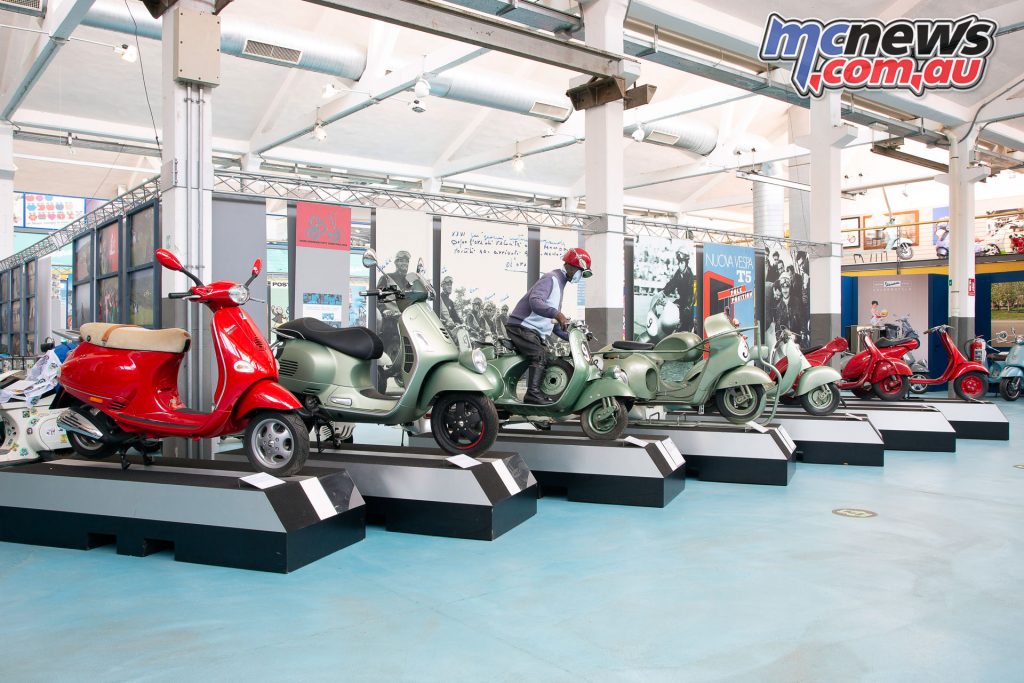
Then we have the present day and a nod to the future with the essential, elegant lines of the Vespa 946 in its (RED) version that, as of 2016, is the most elegant, stylish way to show sensitivity to a big issue and represents an opportunity to contribute actively to one of civilisation’s toughest battles.
Some of the rarest pieces in the Piaggio Museum are the racing Vespas, several of which have starred in the setting of incredible records: unique pieces like the Vespa Siluro (a 125 with two opposing cylinders, with which rider Dino Mazzoncini set the world record for the 1 km time trial in 1951), the Vespa Montlhéry (that set 17 world records at the track of the same name over a ten-hour period in 1950), the number 94 Vespa Sei Giorni ridden by Giuseppe Cau during the 1951 race in which the Piaggio racing team scored 9 medals and the Vespa 98 and 125 Corsa and Circuito.
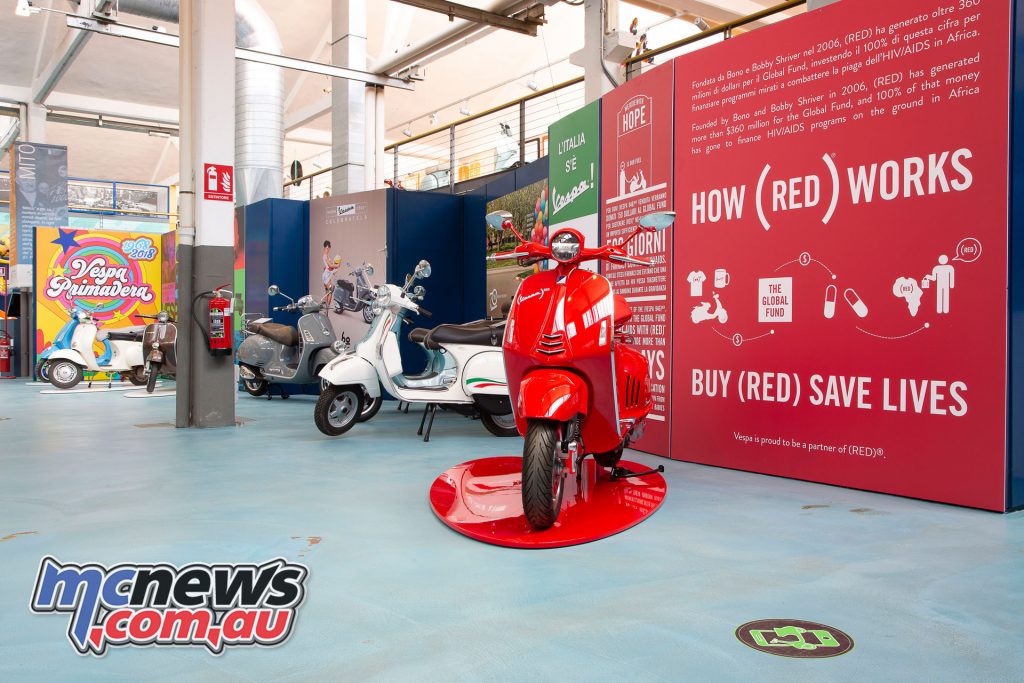
A real point of interest is the Vespa Alpha, a limited edition created for a 1967 film production. The two Vespas destined for military use deserve a chapter of their own: the Vespa 150 TAP, destined for the French forces and armed with a 75 mm anti-tank gun, and the 1964 Vespa Militare 125, created for the Italian Ministry of Defence.
A special area (updated for the occasion with an evocative location-type backdrop) is dedicated to those Vespas that have taken on long and adventurous round-the-world journeys. Among these, the Vespa Dalì stands out for its artistic value. Produced in Spain, two university students, Antonio Veciana and Santiago Guillem, chose this Vespa 150 S for their 1962 “round the world 79-day Vespa trip”.
The Piaggio Collection
The first of the two new rooms open to the public is destined to exhibit the collection dedicated to the Piaggio brand. It comprises bikes that have marked the history of entire generations and played a part in millions of people’s lives.
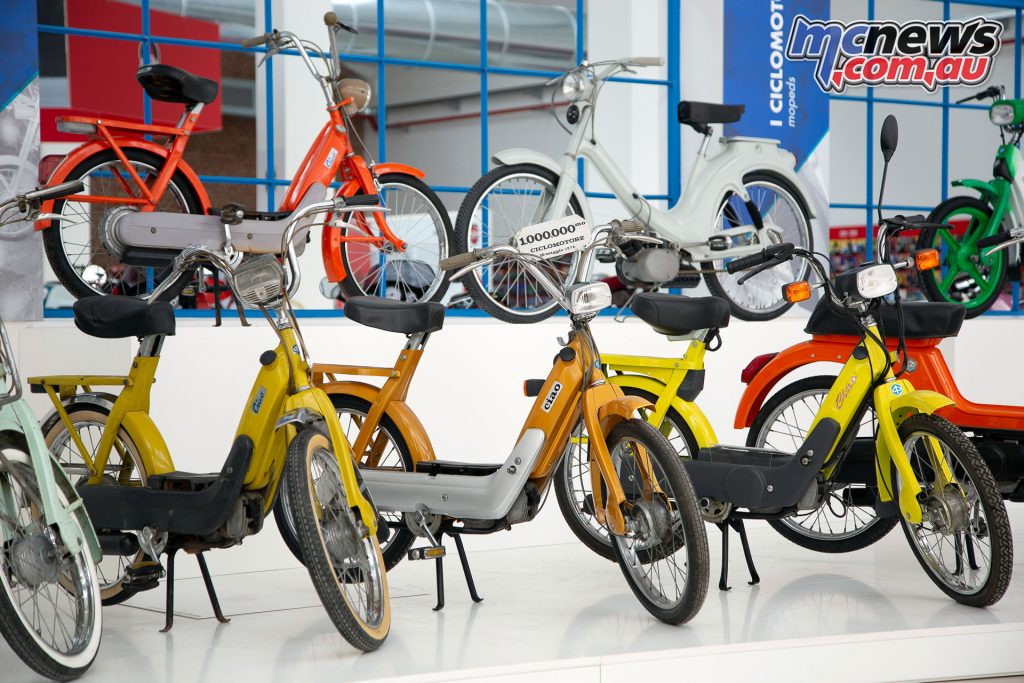
After the total “monopoly” of the Vespa brand, the Piaggio hexagon proved itself with the success of its scooters. 50cc bikes like the Ciao and then the Bravo, Boxer and Sì were the first mode of transport for boys and girls in the 70s, their first taste of freedom. The first 1955 prototype, created by Corradino d’Ascanio, is a real rarity.
Starting with these scooters, the brand evolved with increasingly technological families of scooters and engines, by way of the 1990s Sfera and Quartz, all the way to solutions that were cutting-edge from both a technological and design standpoint, offering very pronounced innovation, the MP3 for example, the first three-wheeled scooter.
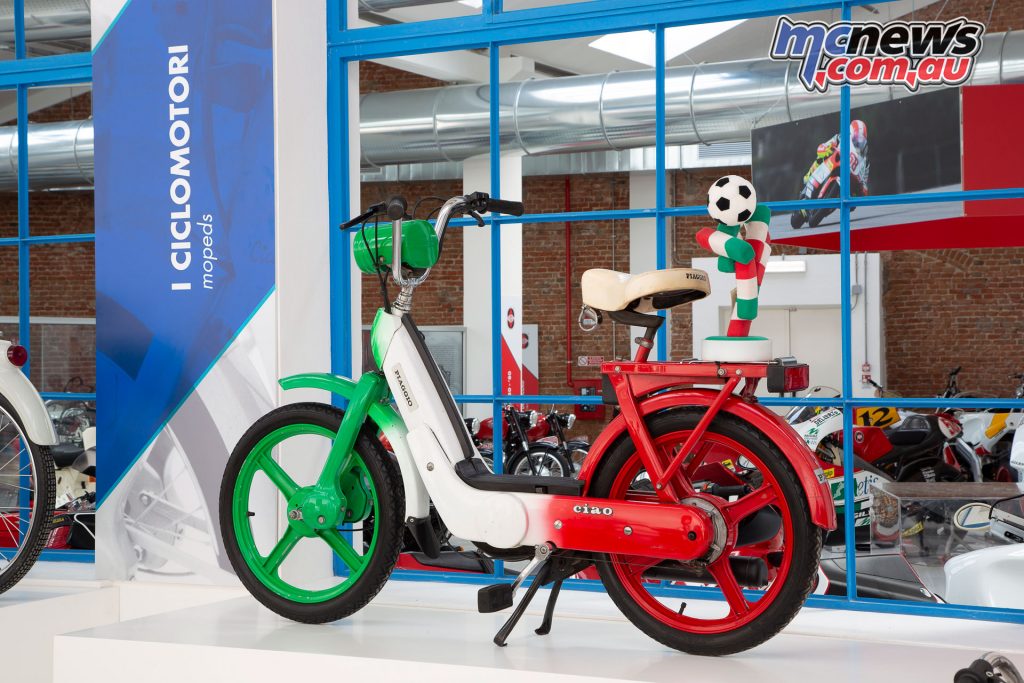
The Ape collection, housed in these rooms, goes from the first model, built in the immediate post-war period to get small-scale goods transportation back in motion, to the 1956 Ape Calessino, designed to transport passengers, and also the Pentarò, a five-wheeler including trailer and a significant example of the different uses of the vehicle, as is the Ape 400 van used by the Italian Post Office.
Another stand-out is the Calessino Presidenziale identical to that donated to the Italian President of the Republic in 2008, to celebrate the 60th anniversary of the Republican Constitution. The Ape TM 703 Eurasia Expedition, the star of a 25,000 km trip from Lisbon to Beijing in 1998, still retains the instrumentation used during the raid.
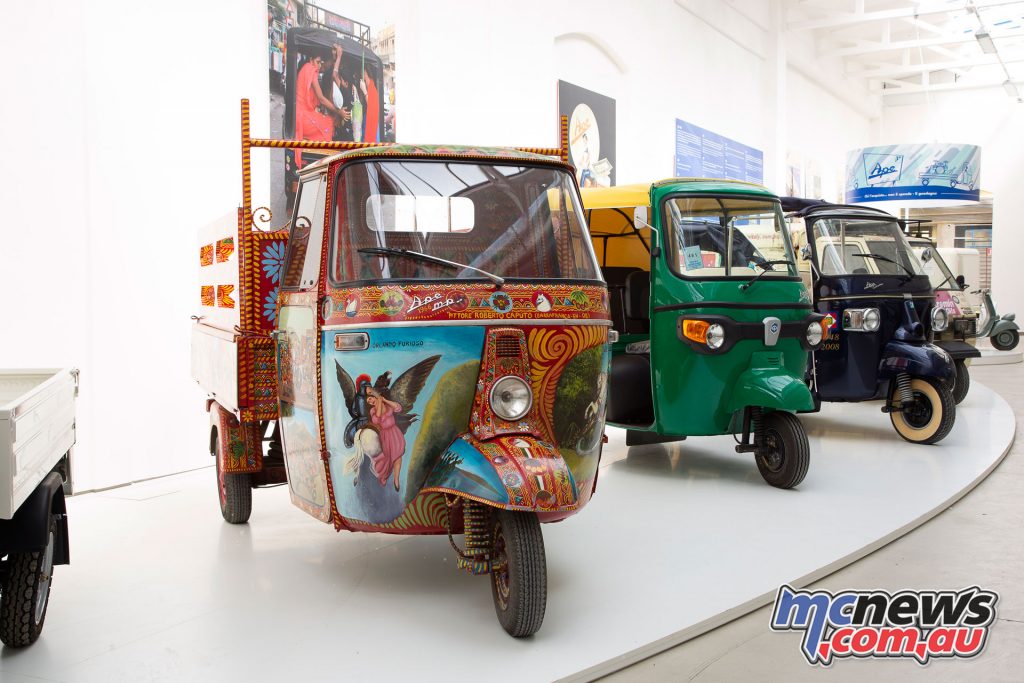
The Ape Sicilian cart, a unique model, entirely hand painted by painter Roberto Caputo in 2008, counterbalances with the small Ape 50 decorated in 2011 by Tuscan artist Giuliano Ghelli (1944-2014). Another new feature that awaits visitors to this room is the cafeteria space, based around a wonderful street food Ape.
Representing Piaggio’s long-term commitment to the commercial field is one of the first models of the four-wheel Piaggio Porter, the versatile minivan launched by the company in 1997.
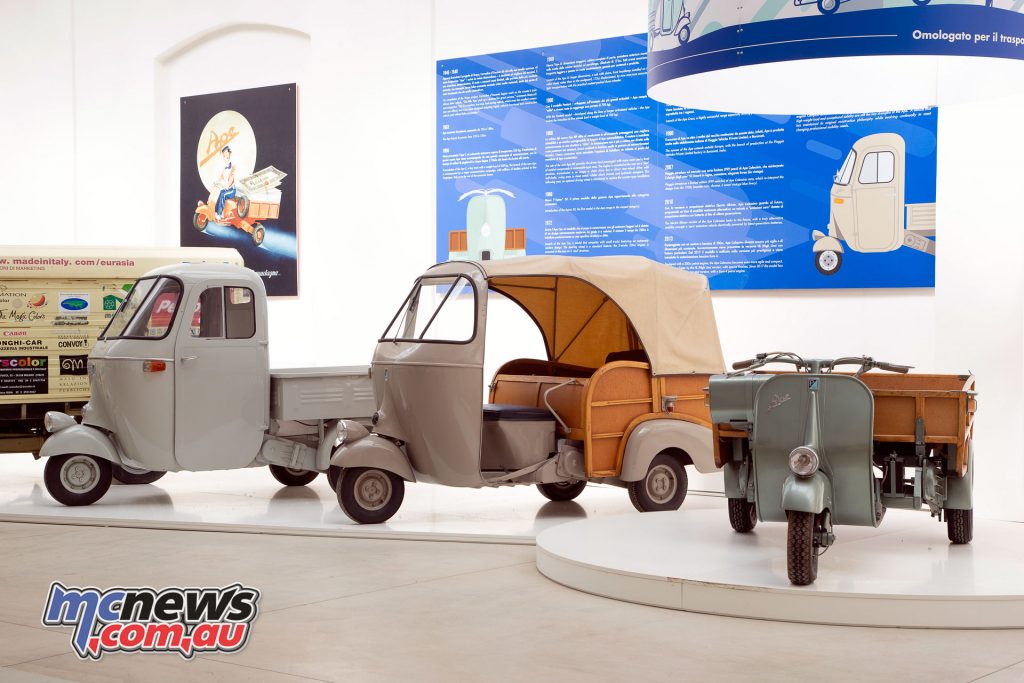
The Piaggio collection is enriched and completed with examples from many transport sectors touched by the Italian brand: the 1950s Moscone outboard motor, the Hydrojet maritime motor and the T111 tractor, both dating back to the 70s.
The Aprilia, Gilera, Moto Guzzi Collections
The real novelty of the new 2018 Piaggio Museum refit is the large exhibition area dedicated to the historic collections of the Piaggio Group’s motorcycle brands, starting with the Gilera collection that, already present right from the first museum configuration, is now enriched with 40 new pieces, the result of a meticulous recovery and restoration operation.
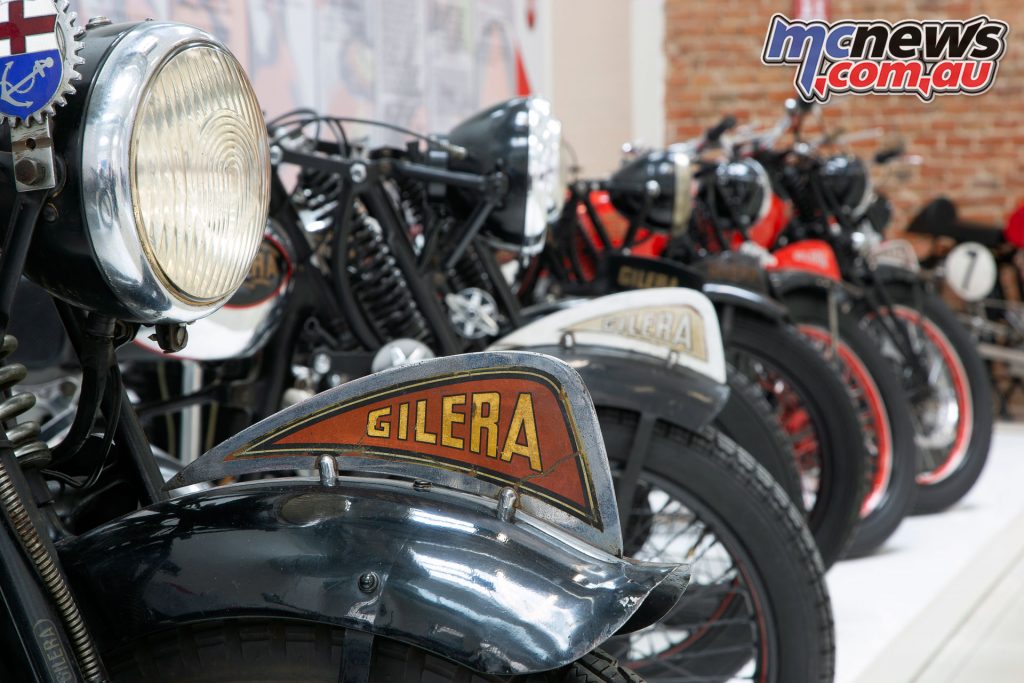
The first motorcycle to be built by Giuseppe Gilera opens a chronological pathway, illustrated with images from the Gilera Historic Archive, which takes in many of the bikes that have contributed to the history of the Arcore motorcycle firm, acquired by Piaggio in 1969.
The 1909 VT 317, the flagship, is characterised by transmission from the crankshaft to the rear wheel using a leather belt and presents a very advanced engine with two overhead valves and large fins on the cylinder and head.
1920s and 30s Gilera production is represented by the 350 Super Sport and the 500 VL Sei Giorni. Following on from the essentially experimental creations of the 1933-34 period, the overhead valve engine – identified with the letters VT – was definitively launched as a standard product in 1935. Among others, the Museum exhibits 500 VT Bitubo models, with their ‘fish tail’ double exhaust with rhomboidal profile, and the 500 Otto Bulloni.
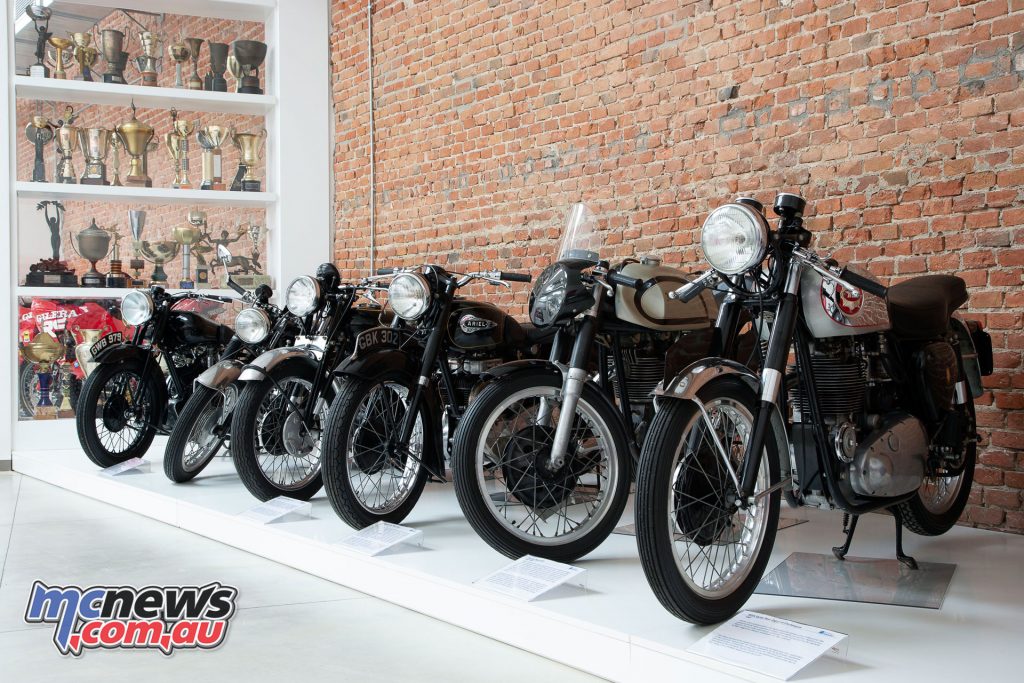
A unique example in this collection is the Gilera Rondine (also exhibited with a fairing), the bike that changed the sporting destiny of the Arcore manufacturer, smashing the 50 and 100 kilometre, and the 50 and 100 mile records, as well as the speed record in 1937, reaching almost 250 km/h.
From then on, the Rondine’s career was studded with speed records and legendary feats such as Monza in 1937 and, that same year, the Milan-Taranto. The next testament to the success of the Gilera brand is the 500 Saturno Sport, launched in 1940, one of the world’s most famous bikes. Of the racing bikes prepared by Giuseppe Gilera for the racing “giant”, there is the Saturno Sanremo and the Saturno Piuma, officially presented in 1952 and a race winner up until 1957. The Piaggio Museum collection also includes the 1952 Saturno Cross, with the racing version of the engine with alloy cylinder, and the 175 Regolarità from 1956.
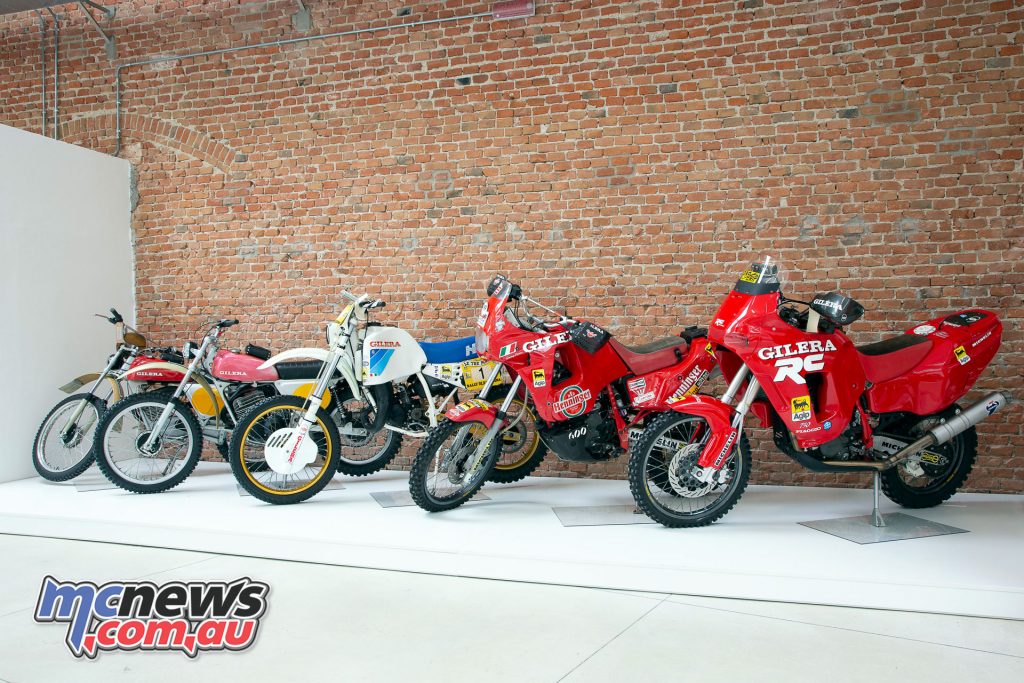
The efforts and victories at racetracks around the world are represented by models such as the 125 and 175 twins and the queen, the 500 Quattro Cilindri, also in a side-car version.
The Gilera Quattro Cilindri is one of the most successful, well-known and celebrated bikes of all time, a winner from 1949 to 1957. Years in which it won 6 Riders’ World Titles and 5 Manufacturers’ World Titles in the 500 class. This, in addition to 6 Italian championships, 7 Grand Prix of Nations as well as many other podiums. In 1956 and 1957, the Quattro Cilindri side-car twice won the Grand Prix of Nations, with driver Albino Milani and his brother Rossano reaching speeds of 190 km/h, exceeding the average of 160 km/h for a Monza lap.
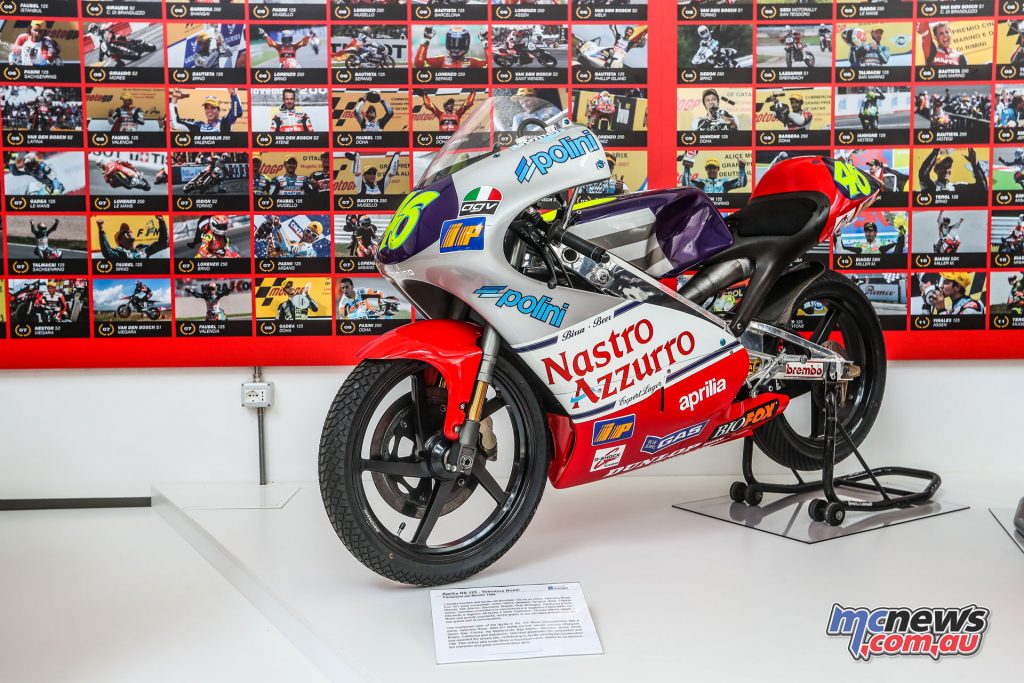
There is also a very recently restored series of race models from the 1980s and 90s.
Fans will be particularly moved as they admire the bike with which Marco Simoncelli scored Gilera its 14th world title in the 250 class in 2008.
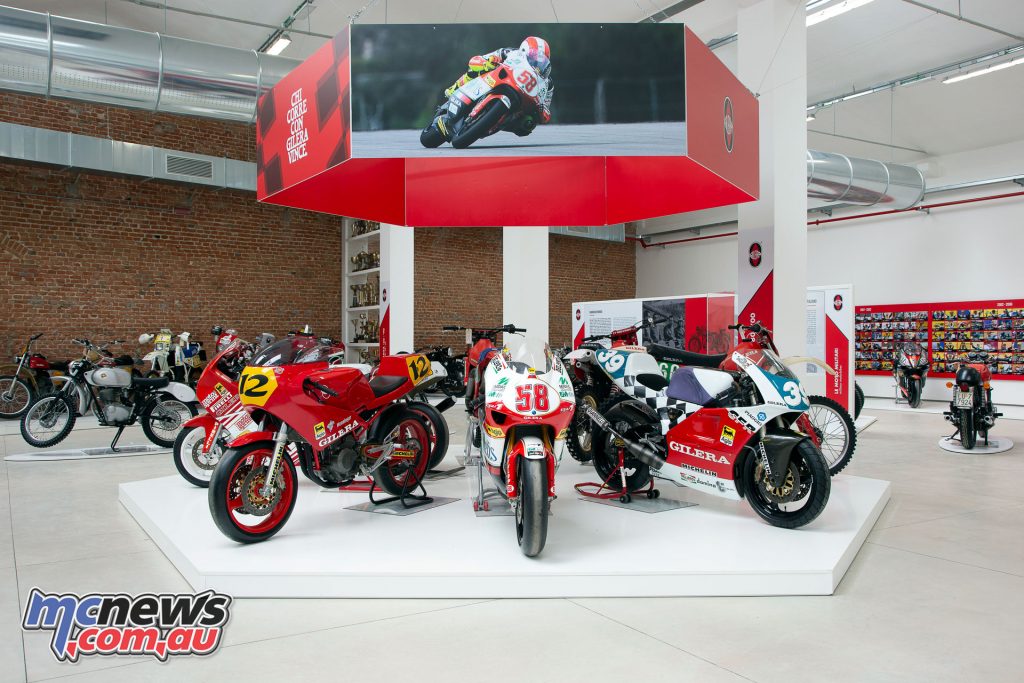
Exhibited for the first time are some of the bikes built for the Italian Army and Finance Police, stand-outs including the Gilera Saturno 500 Militare and the 300 Bicilindrica Guardia di Finanza.
A brand-new section features a small but precious selection of Moto Guzzis, one of which is the extraordinary 1957 Moto Guzzi V8, a mechanical masterpiece and one of the most famous bikes of all time.
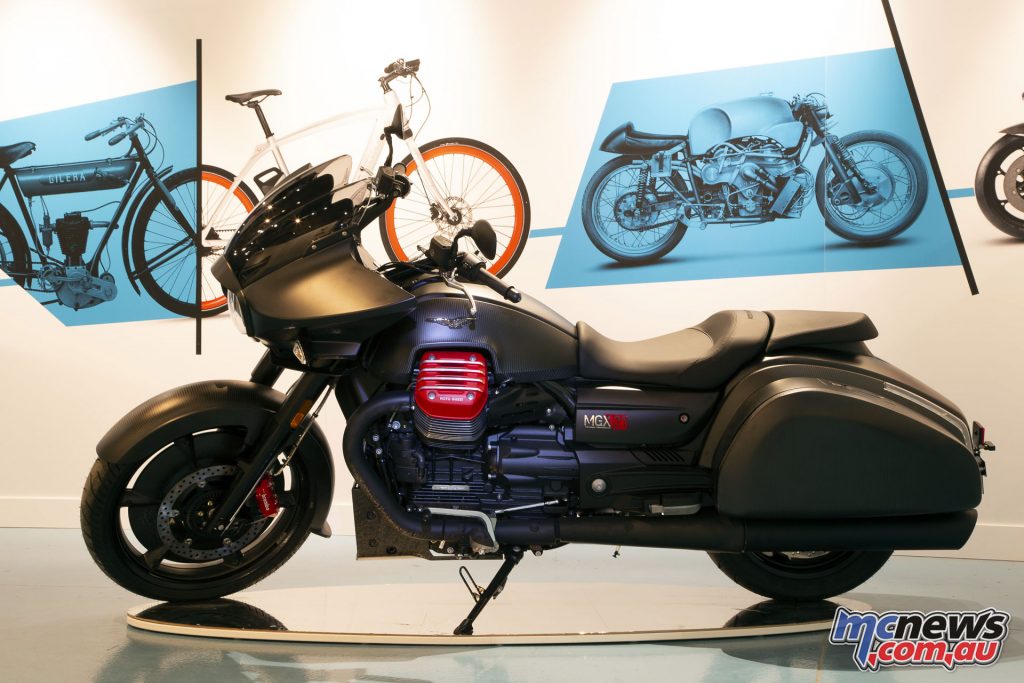
The collection is completed by the highly sought-after 1958 Falcone 500 and the Galletto 175. A truly unique piece is the TOMOTO, an exclusive model customised by British designer Tom Dixon in 2017, to mark the 50th anniversary of the legendary Moto Guzzi V7. Fans of the well-known TV show “Lord of the Bikes”, dedicated to motorcycle customisation, will be able to admire the Moto Guzzi that won the 2016 edition.
To celebrate the 294 GP wins scored by Aprilia , some of the Noale manufacturer’s racing bikes will be exhibited for the first time, against an evocative backdrop that highlights the faces, images and figures of its success.
The world championship winning bikes play a starring role of course: the RS 125 that, in 1997, saw Valentino Rossi become World Champion for the first time, the RSV 250 bikes with which Loris Capirossi and Manuel Poggiali celebrated in 1998 and 2003 respectively, and the RSV4 Factory that led Max Biaggi to victory in the 2010 SBK world championship.
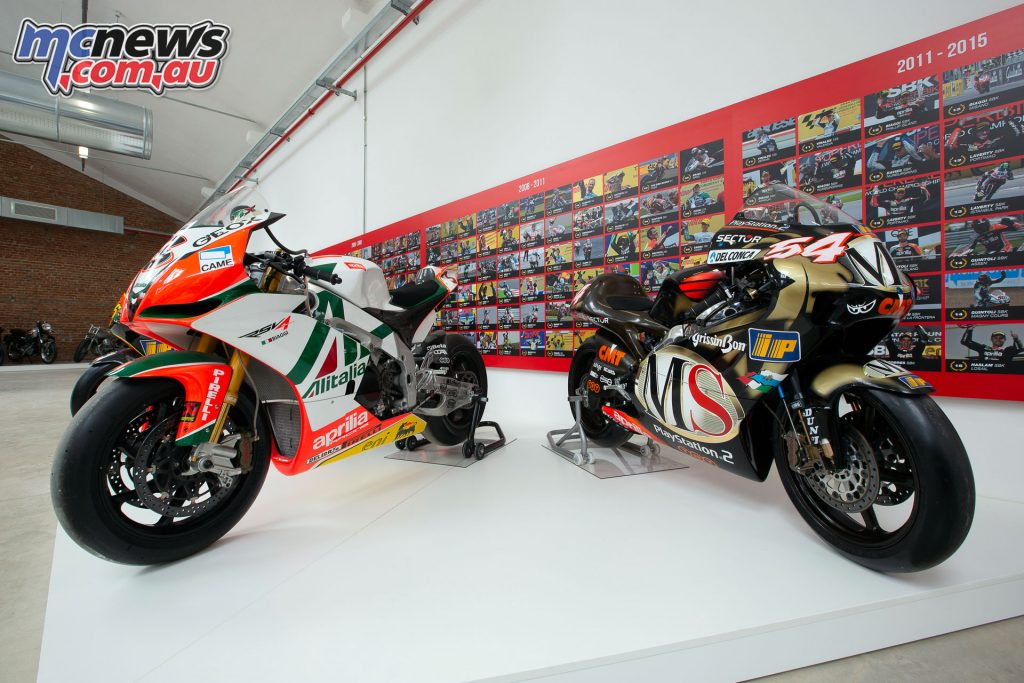
A selection of historic models that have contributed to the international history of motorcycling are also on show: the Brough Superior SS 100, a 1930s legend, the Vincent Black Shadow 1000 the super fast twin with a 1000 CC V engine, the 1950 Ariel Square Four MK1, the 1960 Velocette Venon Clubman and the Norton Manx 500, one of the most famous and successful racing bikes of the 20th century. Alongside these jewels are two examples of production bikes created by historic Vicenza brand Laverda, acquired by Piaggio, along with Aprilia, in 2004: the Laverda SF 750 (1973) and the Laverda 1200 Anniversario (1979).
The Piaggio Museum Art Collection
The Museum has always dedicated an area to the relationship between the Vespa legend and various forms of art, with particular reference to contemporary art and cinema. A space that is consolidated and updated in the new Museum, welcoming interpretations of Vespas offered over the years by artists and designers: a collection of works that are particularly interesting in terms of the variety of styles and materials, the fruit of almost twenty years of cultural activity by the Foundation.
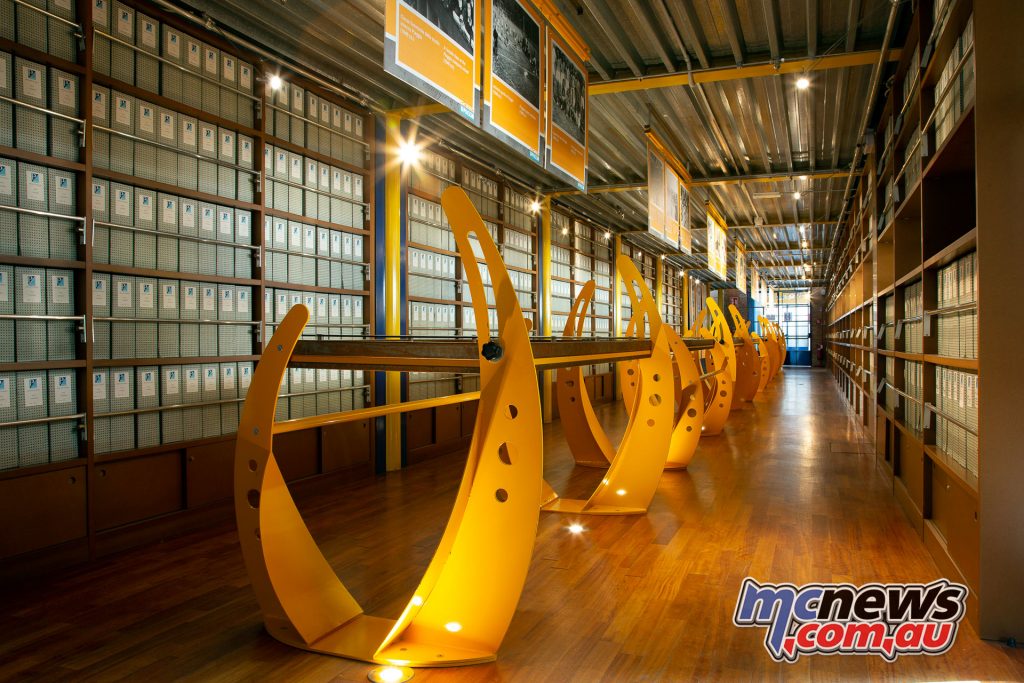
Among these personalised Vespas, the “mythical” reinterpretation by Mino Trafeli is a stand-out, a Vespa characterised by its unusual proportions and alabaster inserts, created during an artist anthology hosted by the Piaggio Museum in 2003. A now consolidated tradition that ensures this section continues to expand and transform, with the acquisition of new Vespas, reinterpreted by various artists and hosted by the Museum, starting with that created in 2010 by Ugo Nespolo for the exhibition “La Vespa e il cinema”.
And so it is that cinema, having played a fundamental role in building the Vespa legend, is given its own dedicated space, with a touchscreen monitor via which to “navigate” among the best scenes of cinematic history to star the Vespa. From Roman Holiday (1953) to Alfie, from La Dolce Vita (1960) to Quadrophenia (1979), by way of Nanni Moretti’s Dear Diary (1993) and The Interpreter by Sydney Pollack (2005).
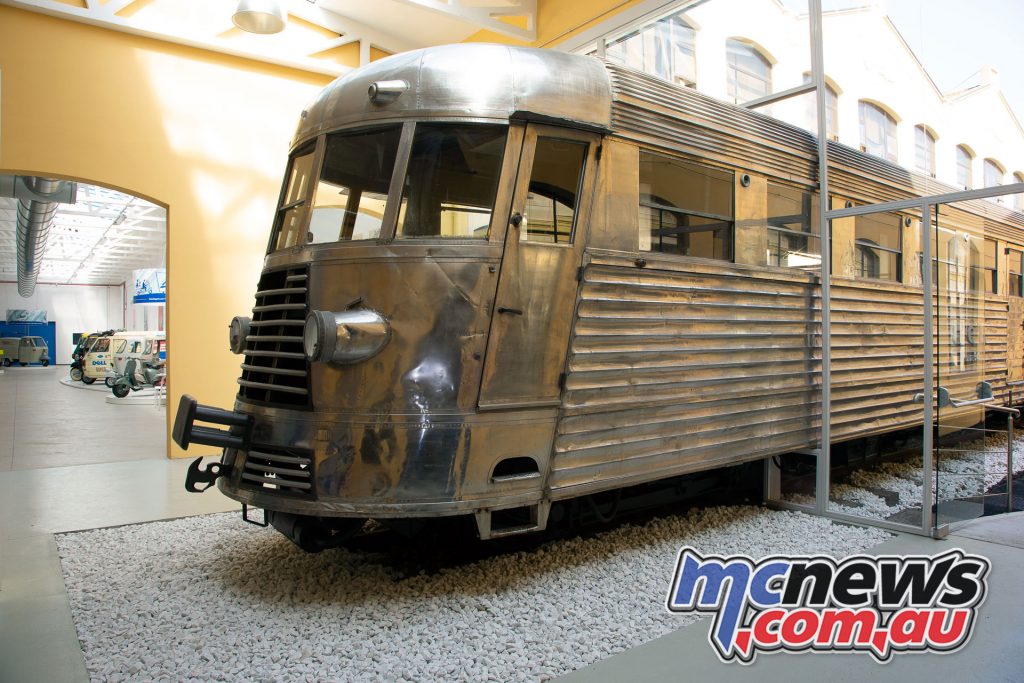
In this area, visitors can admire Vespas interpreted by artists such as Giampaolo Talani, Giorgio Dal Canto, Luca Moretto, Ali Hassoun, as well as some Vespa ET4 models created in 2001 by young designers for the “VespArte” contest, including the “Pezzo Unico” by Nicolino Di Carlo.























